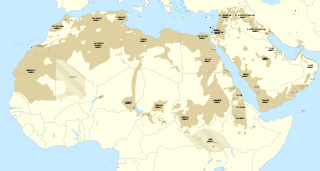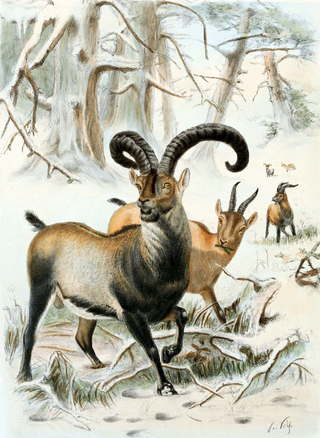
The Semitic languages are a branch of the Afroasiatic language family. They include Arabic, Amharic, Tigrinya, Aramaic, Hebrew, Maltese and numerous other ancient and modern languages. They are spoken by more than 330 million people across much of West Asia, North Africa, the Horn of Africa, Malta, and in large immigrant and expatriate communities in North America, Europe, and Australasia. The terminology was first used in the 1780s by members of the Göttingen school of history, who derived the name from Shem, one of the three sons of Noah in the Book of Genesis.

Extinction is the termination of a taxon by the death of its last member. A taxon may become functionally extinct before the death of its last member if it loses the capacity to reproduce and recover. Because a species' potential range may be very large, determining this moment is difficult, and is usually done retrospectively. This difficulty leads to phenomena such as Lazarus taxa, where a species presumed extinct abruptly "reappears" after a period of apparent absence.

Asia is home to hundreds of languages comprising several families and some unrelated isolates. The most spoken language families on the continent include Austroasiatic, Austronesian, Japonic, Dravidian, Indo-European, Afroasiatic, Turkic, Sino-Tibetan, Kra–Dai and Koreanic. Many languages of Asia, such as Chinese, Persian, Sanskrit, Arabic, Tamil or Telugu, have a long history as a written language.

The International Union for Conservation of Nature (IUCN) Red List of Threatened Species, also known as the IUCN Red List or Red Data Book, founded in 1964, is an inventory of the global conservation status and extinction risk of biological species. A series of Regional Red Lists, which assess the risk of extinction to species within a political management unit, are also produced by countries and organizations.

An extinct language is a language with no living descendants that no longer has any first-language or second-language speakers. In contrast, a dead language is a language that no longer has any first-language speakers, but does have second-language speakers or is used fluently in written form, such as Latin. A dormant language is a dead language that still serves as a symbol of ethnic identity to an ethnic group; these languages are often undergoing a process of revitalisation. Languages that have first-language speakers are known as modern or living languages to contrast them with dead languages, especially in educational contexts.

This page features lists of species and organisms that have become extinct. The reasons for extinction range from natural occurrences, such as shifts in the Earth's ecosystem or natural disasters, to human influences on nature by the overuse of natural resources, hunting and destruction of natural habitats.

Pterygota is a subclass of insects that includes all winged insects and groups who lost them secondarily.
The conservation status of a group of organisms indicates whether the group still exists and how likely the group is to become extinct in the near future. Many factors are taken into account when assessing conservation status: not simply the number of individuals remaining, but the overall increase or decrease in the population over time, breeding success rates, and known threats. Various systems of conservation status are in use at international, multi-country, national and local levels, as well as for consumer use such as sustainable seafood advisory lists and certification. The two international systems are by the International Union for Conservation of Nature (IUCN) and The Convention on International Trade in Endangered Species of Wild Fauna and Flora (CITES).

Barbacoan is a language family spoken in Colombia and Ecuador.
Neontology is a part of biology that, in contrast to paleontology, deals with living organisms. It is the study of extant taxa : taxa with members still alive, as opposed to (all) being extinct. For example:

An IUCN Red List Critically Endangered species is one that has been categorized by the International Union for Conservation of Nature as facing an extremely high risk of extinction in the wild. As of December 2023, of the 157,190 species currently on the IUCN Red List, 9,760 of those are listed as Critically Endangered, with 1,302 being possibly extinct and 67 possibly extinct in the wild.

A species that is extinct in the wild (EW) is one that has been categorized by the International Union for Conservation of Nature as only consisting of living members kept in captivity or as a naturalized population outside its historic range. Classification requires exhaustive surveys conducted within the species' known habitat with consideration given to seasonality, time of day, and life cycle. Once a species is classified as EW, the only way for it to be downgraded is through reintroduction.
Adrianitidae is a family in the Adrianitaceae, a superfamily of ammonites in the cephalopod order, Goniatitida, known from the Middle Pennsylvanian to the Middle Permian.
Adrianitinae is a subfamily of the Adrianitidae which is part of the goniatitid superfamily Adrianitaceae. The Adrianitinae which comprise the more advanced genera in the Adrianitidae have sutures that form 14 to 30 lobes. Shells may be discoidal or globular or in between.
Texoceras is an extinct ammonoid genus in the monotypic goniatitid subfamily Texoceratinae, included in the family Adrianitidae. These were shelled cephalopods more closely related to squids, belemnites, octopuses, and cuttlefish than to nautiloids from which they are derived.

An extinct comet is a comet that has expelled most of its volatile ice and has little left to form a tail and coma. In a dormant comet, rather than being depleted, any remaining volatile components have been sealed beneath an inactive surface layer.
Tandia is an extinct Austronesian language in the putative Cenderawasih family of Indonesian Papua. Most speakers have shifted to Wandamen. In 1991, there were only two speakers of Tandia in the world, who they both lived just south of the Wohsimi River on the Wandamen Peninsula, Irian Jaya Province, Indonesia. It was confirmed to be a living language in 2009, but by 2024, it was found to have gone extinct by a linguistic survey team.
Luhu is an extinct Austronesian language spoken in the west of Seram Island in eastern Indonesia. It was spoken in Luhu village on Hoamoal Peninsula at the western end of Seram, and in Boano and Kelang islands, off the western tip of Seram Island.

De-extinction is the process of generating an organism that either resembles or is an extinct species. There are several ways to carry out the process of de-extinction. Cloning is the most widely proposed method, although genome editing and selective breeding have also been considered. Similar techniques have been applied to certain endangered species, in hopes to boost their genetic diversity. The only method of the three that would provide an animal with the same genetic identity is cloning. There are benefits and drawbacks to the process of de-extinction ranging from technological advancements to ethical issues.











